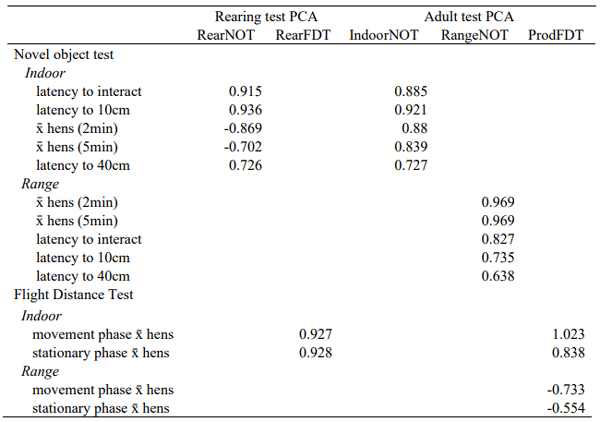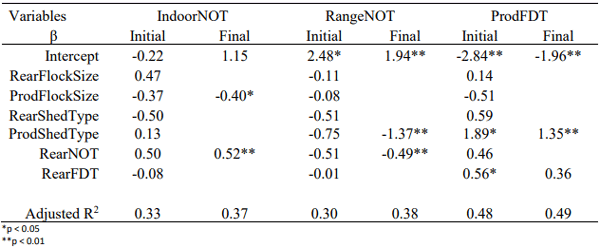I. Introduction
Early life experiences play an important role in the behavioural development of laying hens (Janczak and Riber 2015; Nicol 2015). Environmental differences in rearing systems have been shown to have an impact on behavioural problems such as feather pecking and cannibalism during adulthood (de Haas et al. 2014; Riber and Guzman 2017). In addition, fearfulness early in life has been shown to correspond to increased stress response in adulthood (de Haas et al. 2012). A greater understanding of the rearing conditions and their influence on hen behaviour during rearing and adulthood may assist in the prevention or mitigation of problem behaviours and therefore assist in the reduction of mortality and improvement of welfare in free-range laying hens (Campbell et al. 2019). This study examined the behavioural response of commercial free-range laying hens to humans and novelty during rearing and at peak lay. It was hypothesised that the behavioural response of pullets to humans and novelty would be predictive of their respective responses to humans and novelty, respectively, in adulthood.
II. Method
This study was approved by the Animal Ethics Committee of the University of Melbourne (Ethics ID 1814708.1). Behaviour tests were conducted in-situ on 45 flocks (Hy-line brown, n=37; and ISA Brown, n=8) during rearing (15-16 wk old) and 39 adult flocks (45-55 wk old). Of the all the flocks tested, 26 flocks were tested at both rearing and in adulthood. Flocks were reared in either floor rearing (n=17) or JumpStart/Aviary systems (n=28). Adult flocks were housed in either flat deck systems (n= 20) or aviary systems (n=19) and had range access. Flock sizes ranged from 19,203 to 67,297 in rearing and 16,897 to 61,000 in adulthood. The two behaviour tests were a flight distance test (FDT) and a novel object test (NOT) and bird responses were video recorded. The FDT involved an observer moving through the shed (and range for adult flocks) in a standard manner stopping every 20 steps for 30 s. In the NOT a children’s toy was presented in three locations in the shed and range (for adult flocks). The number of hens within 1.5 m in front of the observer was recorded at every step when the observer was moving, and every 30 s whilst the observer was stationary in the FDT. The latency for hens to approach within 10 and 40 cm and interact with the novel object (NO), and the average number of hens within 40 cm of the NO were recorded every 30s over 5 mins in the NOT.
A principal component analysis (PCA) with oblique rotation was performed in SPSS (version 27) separately on the two full sets of data from the behaviour tests conducted during rearing and with adult hens to identify sets of components that represent the underlying commonalities (components) in these tests and regression factor scores were calculated. Prior to analysis, all variables were transformed using inverse, log10 or square root transformations to normalise the data. Since the correlation coefficients were all above the required 0.3, the Kaiser-Meyer-Olkin (KMO) values exceeded the recommended value of 0.6, and Bartlett’s Test of Sphericity was statistically significant, the data were considered suitable for the PCA. A backwards stepwise regression was used to identify possible predictors of each of the component scores from the behaviour tests conducted in adulthood using data from the 26 flocks with both rearing and adult behaviour test data. At each step variables were removed based on p-values (p < 0.1).
III. Results
Two components each with eigen values greater than 1 were extracted in the PCA for the tests during rearing, these were labelled RearFDT and RearNOT, and three components, all with eigen values greater than 1 were extracted in the PCA for the tests conducted on adult hens, these were labelled ProdFDT, IndoorNOT and RangeNOT (See Table 1 for component descriptions and loadings). In the resulting scores, a high score in both RearFDT and ProdFDT corresponds with more pullets/hens within 1.25m of the human in both stationary and movement phases. A high score in both the RangeNOT and the IndoorNOT corresponds with less pullets/hens near the NO and longer latency to approach and interact.
Table 1 - Pattern Matrix for PCA with Oblique Rotation of two factor solution of rearing behaviour test items and 3 factor solution of adult behaviour test items

The variables included in the original model and the final model of the regression are outlined in Table 2. Among the behaviour test variables from rearing, the NOT conducted during the rearing was predictive of the NOT conducted with adult hens both in the range and inside the shed; however this relationship was positive for the adult NOT tests conducted inside the shed, and negative for the NOT tests conducted in the range (i.e. flocks with a higher score in the NOT at rearing, are predicted to have a higher score in the NOT conducted in the shed and a lower score in the NOT conducted in the range during adulthood). The FDT in rearing remained in the final model predicting behaviour in the FDT for adult laying hens. Housing system for adult laying hens was predictive of both their response to the NOT in the range and during the FDT in adult flocks, with hens in aviary systems predicted to score lower in the NOT and higher in the FDT than hens in flat deck systems.
Table 2 - Unstandardised coefficients and adjusted R2 for the initial and final regression model where RearFlockSize is the number of pullets (x 10,000), ProdFlockSize is the number of hens (x 10,000), RearShedType is the rearing housing system (Foor = 1, Aviary/JumpStart =2), ProdShedType is the adult hen housing system (Flat Deck = 1, Aviary = 2).
IV. Discussion
It should be recognised that the two tests FDT and NOT were designed to measure the approach and avoidance responses of birds to humans and a novel object. Measures of exploration are often interpreted as providing information about fearfulness and are the basis of some of the standard tests of fear (Bateson and Matheson 2007). Although it is unclear how exactly fear and exploration, particularly curiosity or inquisitive exploration, are related, it is generally agreed that high levels of fear inhibit all other motivational systems including exploration (Feenders et al. 2011).
Several relationships were found in the present study between fear of humans and novelty (or conversely curiosity) in adulthood and fear of humans and novelty and housing system. These relationships indicate that the behavioural responses of pullets to both novelty and humans, and housing system in adulthood were predictive of the behavioural responses of hens to novelty and humans in adulthood. For example, the behavioural responses of pullets to humans and the housing system in adulthood were related to the behavioural responses of adult hens to humans (both indoors and outdoors), with less fear of humans during rearing and housing in aviaries in adulthood associated with less fear of humans in adulthood. The behavioural responses of pullets to novelty and housing system in adulthood were related to the behavioural responses of adult hens to novelty outdoors, with less fear of novelty during rearing, and housing in flat deck systems in adulthood, associated with increased fear or less exploration of novelty on the range. While housing in adulthood was not predictive of the behavioural responses of hens to novelty indoors, the behavioural responses of pullets to novelty and adult flock size were related to the behavioural responses of adult hens to novelty indoors. This relationship indicates that less fear of novelty during rearing and larger flock size were associated with less fear of novelty or increased curiosity indoors in adult laying hens.
The observed relationships do not demonstrate causality and experimental studies are necessary to determine causality. However, it is useful to consider these relationships since fear or conversely curiosity may have implications on hen welfare. For example, housing in aviaries in adulthood was associated with reduced fear (or conversely increased curiosity) of humans in adulthood and with reduced fear of novelty outdoors in adulthood. While further research is clearly required, housing in aviaries may provide hens when indoors with more visual contact with stockpeople routinely moving through the sheds than housing in flat decks, because of the opportunity for hens in aviaries to locate themselves in elevated positions. Furthermore, this vertical separation from stockpeople may be less threatening to hens and facilitate increased curiosity. The increased visual contact with humans which may occur for those hens housed in aviaries may also be a form of environment enrichment and it has been shown in poultry that environmental enrichment can reduce fear of novel stimuli and humans in laying hens (Hemsworth and Edwards 2021).
These findings also indicate that the behavioural response of pullets to humans and novelty is predictive of their respective responses to humans and novelty, respectively, in adulthood. Indeed, as Campbell et al. (2019) has proposed, rearing conditions and their influence on hen behaviour during rearing and adulthood may affect problem behaviours, mortality and productivity of free-range laying hens. The research reported in the present paper is part of a large prospective observational study to identify risk factors for smothering in Australian free-range layer flocks and the behavioural responses of pullets and adult hens to humans and novelty are some of the risk factors being studied.
ACKNOWLEDGEMENTS: This study was funded by Australian Eggs Ltd.
Presented at the 33th Annual Australian Poultry Science Symposium 2022. For information on the next edition, click here.











.jpg&w=3840&q=75)